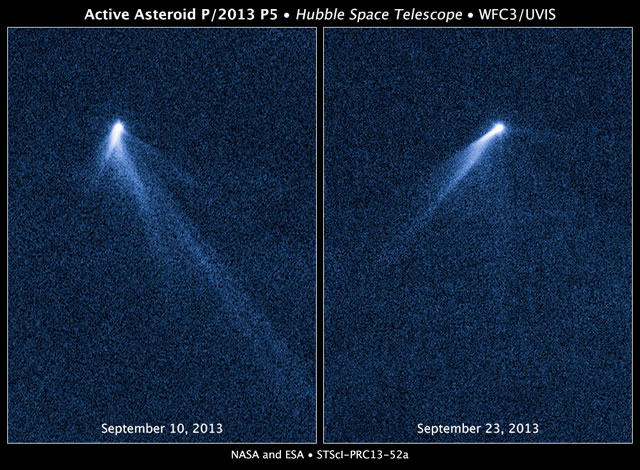
P/2013 P5 – Credit: NASA, ESA, and D. Jewitt (UCLA)
I normali asteroidi dovrebbero apparire semplicemente come piccoli punti di luce, ma questo asteroide, denominato P/2013 P5, ha sei code di polvere come hanno le comete, che si irradiano dal corpo celeste come raggi di una ruota. Poichè nulla di simile è stato mai visto prima, gli astronomi sono non poco impegnati per trovare una spiegazione adeguata per il suo aspetto letteralmente fuori da questo mondo. “Siamo stati realmente sbalorditi quando l’abbiamo visto”, ha detto il ricercatore David Jewitt dell’Università della California di Los Angeles. “
Ancora più sorprendente, è il fatto che le sue strutture della coda cambiano drammaticamente in soli 13 giorni in quanto l’eruzione di polvere è continua. Anche questo ci ha colto di sorpresa. E ‘difficile credere che stiamo guardando un asteroide.” Un’interpretazione possibile è che la velocità di rotazione dell’asteroide è aumentata a tal punto che la sua superficie ha iniziato a disgregarsi volando esternamente, vista la quantità di polvere espulsa in eruzioni episodici a partire dalla scorsa primavera. La squadra di scienziati esclude che si tratti di un recente scenario di impatto dell’asteroide, perché la dinamica sarebbe stata diversa e la polvere si sarebbe vista esplodere nello spazio in un unico evento, mentre P5 ha espulso polvere per almeno cinque mesi. L’asteroide è stato scoperto come un oggetto insolitamente sfocato visto con il telescopio per survey Pan- STARRS alle Hawaii. Le molteplici code sono state scoperte attraverso le immagini di Hubble scattate il 10 settembre, 2013. Quando Hubble tornò a riprendere l’asteroide pochi giorno dopo, il 23 settembre, il suo aspetto era completamente cambiato. Sembrava come se l’intera struttura avesse oscillato intorno.” Eravamo completamente atterriti”, ha detto Jewitt .
Normal asteroids should appear simply as tiny points of light. But this asteroid, designated P/2013 P5, has six comet-like tails of dust radiating from it like spokes on a wheel. Because nothing like this has ever been seen before, astronomers are scratching their heads to find an adequate explanation for its out-of-this-world appearance. “We were literally dumbfounded when we saw it,” said lead investigator David Jewitt of the University of California at Los Angeles.
“Even more amazing, its tail structures change dramatically in just 13 days as it belches out dust. That also caught us by surprise. It’s hard to believe we’re looking at an asteroid.” One interpretation is that the asteroid’s rotation rate increased to the point where its surface started flying apart, ejecting dust in episodic eruptions starting last spring. The team rules out a recent asteroid impact scenario because a lot of dust would be blasted into space all at once, whereas P5 has ejected dust for at least five months. The asteroid was discovered as an unusually fuzzy-looking object with the Pan-STARRS survey telescope in Hawaii. The multiple tails were discovered in Hubble images taken on Sept. 10, 2013. When Hubble returned to the asteroid on Sept. 23, its appearance had totally changed. It looked as if the entire structure had swung around. “We were completely knocked out,” Jewitt said.
Source/Continue reading → Phys.org





















